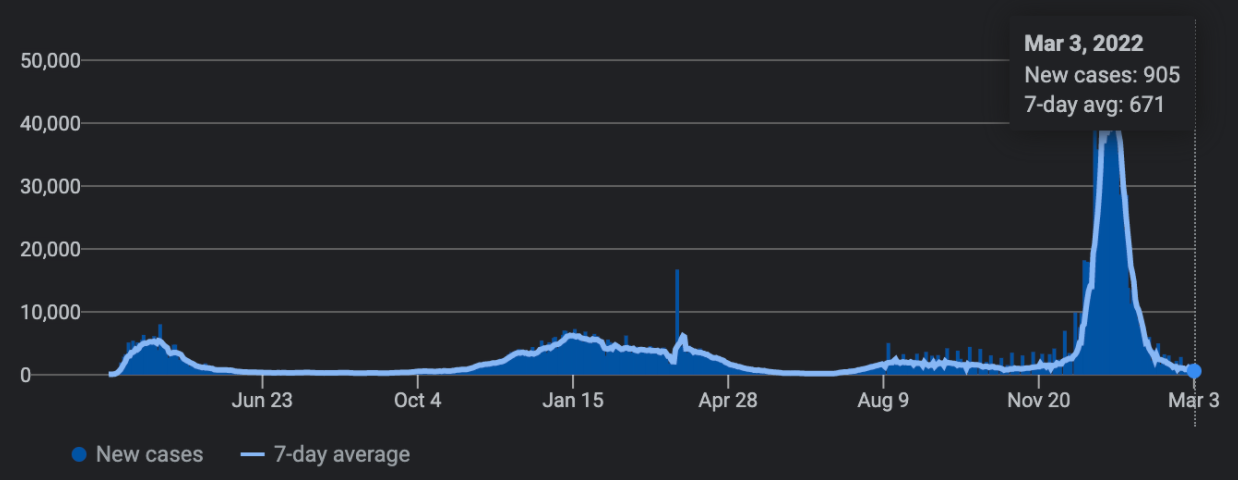On March 3rd, 2022, the Fieldston’s campus buzzed with excitement when an announcement came out in the morning: Fieldston was to become mask optional on Wednesday, 3/9. The date marks the exact two year anniversary of the Fieldston campus shutting down when COVID-19 was first spreading around New York City, and will be a huge step in return to normalcy on campus.
In late December and early January, the Omicron variant swept through the Fieldston community, New York City, and the entire nation. After a case spike of unmatched height, the Center for Disease Control and Prevention (CDC) recommended use of high-quality, multilayer masks (3-ply disposable masks, KN95s, N95s, KF94s, etc.).
However, the spike went down as quickly as it went up, and as of March 3rd, the case average is as low as it was during the lowest case rates of the pandemic. The CDC has loosened its guidelines and, according to its useful risk by county tool, it is safe for over 90% of Americans to unmask in their communities.
This does not mean that the U.S. is done with masking forever. As has been the case throughout the pandemic, the CDC and individual states will continue to update guidelines as case and positivity rates fluctuate. Teddy O’Rourke, the Director of Campus Services, is involved in making many COVID-19 precaution decisions. He said, in the coming months and years “while I do expect to see fewer masks in public areas as city and state orders shift, I believe masks will continue to remain a facet of many individual’s everyday lives. To varying extents, individuals have developed a tolerance for masks and I believe we’ll continue to see them used to prevent seasonal cold and flu, on public transportation, and to relieve social anxiety in the months and years to come.”
Masking in schools has been a controversial topic since fall of 2021, when schools around the country were reopening and deciding how to return safely while prioritizing the mental health of students. States in the tri-state area (New Jersey, Connecticut, and New York) mandated masks. In the first week of February, New Jersey’s Governor Philip D. Murphy and Connecticut’s Governor Ned Lamont announced that their mandates were being dropped on Monday, March 7th in light of the lower case rates.
New Yorkers anxiously awaited Governor Kathy Hochul’s response until February 27th, when she announced that the state mask mandate in schools would end March 2nd, noting, “This is a huge step forward for our kids and communities and I am grateful to the students, educators and parents for their dedication to keeping us all safe—we’ve reached this milestone because of your hard work.”
State Health Commissioner Dr. Mary T. Bassett (‘70) announced “as Governor Hochul said, we will remain vigilant as New York moves forward, and our team at the Department of Health will continue to monitor the data and advance early warning monitoring systems like wastewater surveillance. We continue to urge all New Yorkers to get vaccinated and get boosted, and we will work with our partners in education statewide to ensure our schools, teachers, and students have the support they need to keep our classrooms healthy and safe.”
This announcement, however, was not the last one needed for New York City’s schools to unmask. NYC’s mayor Eric Adams gave the final approval for public schools to unmask on March 7th on March 4th, but had been planning to do so throughout the week.
As an independent school, Fieldston makes its own decisions surrounding COVID-19 protocols. According to O’Rourke, this process is rigorous but incredibly important. “From ventilation controls to sick policies, ECFS has implemented a layered mitigation strategy to ensure the health and safety of our community remains at the center of our operations. These policies were designed specifically with scalability in mind, meaning that should we be required to dial-up or pull back on mitigation strategies, we would be able to do so. Anytime a policy revision is considered, we first turn to public policy. The NYS Department of Health, the NYC Department of Health and Mental Hygiene, the NYS Department of Education, and the Centers for Disease Control and Prevention all issue a variety of frequently-changing guidelines, advisories, and orders. Our COVID-19 Response Team members regularly review and interact with these departments to ensure our decisions are permissible by state or city standards. We also review the latest briefings from the Centers for Disease Control and Prevention, the American Academy of Pediatrics, and the World Health Organization to help shape our understanding of the most current scientific data, allowing us to make an evidence-based decision. Our team will then review state and city community transmission data, as well as our own internal metrics including our student and employee absentee rate, trending number of students or employees sent home due to potential illness, the number of students or employees exhibiting symptoms, student and employee positivity rates, the rate and types of transmission, and general compliance with COVID-19 mitigation policies.
“The COVID-19 Response Team meets regularly to review, design, and operationally plan for these changes. Members of the COVID-19 Response Team include representatives from Campus Services, Operations, Human Resources, and our full Nursing and Medical Technician team. We also consult with a physician team from Independent School Management (ISM), our own physician medical director, and our fellow independent schools. The process of changing COVID-19 protocols can take anywhere from a few days to several weeks depending on CDC forecasts, our current data outlook, and the time it would take to operationalize a change. Just as important are the few weeks following any policy change where our team is closely monitoring our COVID-19 data to ensure that we are not noting a spike in positivity or symptomatic rates. Policy changes are designed to be incremental and measurable for this purpose,” he described
On Monday, February 28th, O’Rourke sent a memo that masks would be in place for the week. By Thursday, a decision had been made: Fieldston would go mask-optional on March 9th.
This decision was made based on data and trends previously seen throughout the pandemic. The memo reads “Our entire community of age-eligible students, faculty, staff, and contractors is fully vaccinated for COVID-19 — with exceptions permitted for bonafide medical and religious reasons. Our COVID-19 positivity rate is currently 0.2%, and we will continue to adhere to our layered mitigation strategies of robust screening testing, ventilation, physical distancing, cleaning/disinfection, and firm sick policy.”
Pre-K and Kindergarten classes will remain masked. Additionally, students who return to school after a 5-day isolation period will mask for the remainder of the 10-days since their isolation started. Masks will still be required in the nurse’s offices and isolation rooms.
Prior to the announcement of this new policy, O’Rourke noted that policies will continue to change based on a variety of factors. “As we do for all COVID-19 policy changes, re-evaluating the mask mandate involves a series of public policy and scientific data reviews, consultation with our COVID-19 Response Team and physicians, and a review of our internal COVID-19 metrics as described above. For the mask mandate in particular we are also reviewing the relationship between masking and social-emotional learning and are evaluating our existing mitigation strategies and infrastructure (e.g., screening testing, ventilation systems, etc.) and how those components would interact with any change to the mask mandate.”
As the community excitedly adjusts to seeing fewer masked faces, we must uphold responsibility and respect for everyone regardless of their choice about masking.






